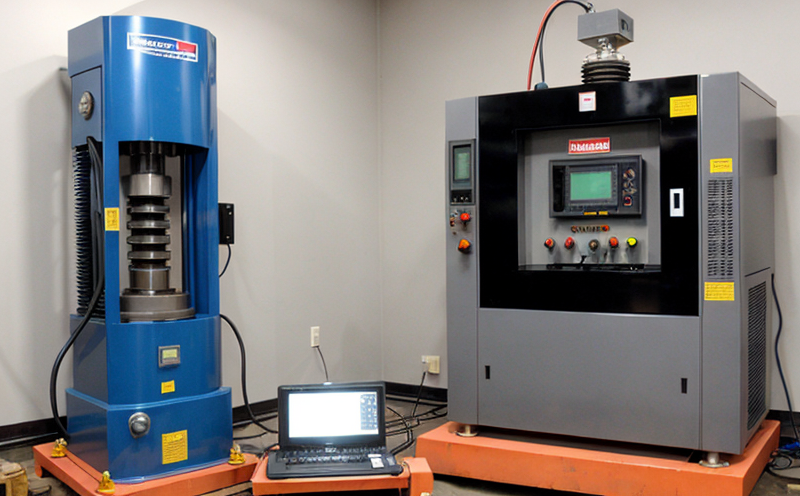SAE J1211 Vibration Testing for Automotive Electronic Equipment
The SAE (Society of Automotive Engineers) J1211 standard is a critical benchmark in the automotive industry, particularly relevant to electronic equipment. This standard provides specifications and procedures for conducting vibration tests on automotive electronic components to ensure their durability under various environmental conditions. The primary goal is to simulate real-world shock and vibration that these devices might encounter during vehicle operation.
The SAE J1211 test protocol involves subjecting the electronic equipment to controlled levels of mechanical shock and vibration over a specified duration. This testing process helps identify potential weaknesses in design, manufacturing processes, or materials used in the construction of automotive electronics. By adhering strictly to these guidelines, manufacturers can ensure that their products meet stringent reliability requirements before they reach consumers.
One key aspect of SAE J1211 testing is understanding how different frequencies and amplitudes affect electronic components. For instance, lower frequency vibrations may simulate road conditions while higher ones could represent more intense shocks experienced during accidents or off-road driving scenarios. Similarly, varying amplitude levels help assess the robustness of various parts against moderate to severe stresses.
Another important consideration is temperature cycling combined with vibration testing. Many automotive environments experience wide swings in temperature which can impact electronic performance significantly. Therefore, it's essential for labs performing SAE J1211 tests to maintain precise control over both environmental factors as well as mechanical inputs during the test cycle.
To perform this type of testing accurately requires specialized equipment capable of generating precise vibrations across a range of frequencies and amplitudes. Additionally, there needs to be appropriate software tools available for monitoring and recording data throughout the duration of each test run. Compliance with international standards such as ISO/TS 16949 ensures that all tests conducted are consistent and repeatable.
In summary, SAE J1211 vibration testing is crucial in ensuring the longevity and reliability of automotive electronics by simulating real-world conditions through controlled environments. It plays an integral role in product development cycles where quality assurance teams rely on this process to make informed decisions about design changes or improvements needed before mass production.
Benefits
- Maintains compliance with industry standards and regulations.
- Identifies potential weaknesses early in the development cycle, reducing costly rework later on.
- Ensures consistent performance across all production batches by maintaining strict quality control measures during testing.
- Improves overall product reliability and customer satisfaction through enhanced durability against environmental stressors.
Quality and Reliability Assurance
Implementing SAE J1211 vibration testing is essential for maintaining high standards of quality within the automotive industry. By adhering to this standard, manufacturers can ensure that their electronic components will perform reliably under challenging conditions without compromising safety or functionality.
The process begins with thorough preparation of the specimens to be tested. This includes cleaning and conditioning them according to specified protocols outlined in the SAE J1211 document. Once ready, these components are placed into a vibration test chamber where they undergo rigorous simulation exercises designed to replicate various types of shocks and vibrations experienced during typical vehicle usage.
During the actual testing phase, precise control over frequency ranges and amplitude levels allows for detailed analysis of how each component responds under different conditions. This information is then used by engineers to refine designs or identify areas requiring improvement before full-scale production begins. The use of advanced instrumentation ensures accurate measurement and recording of all relevant parameters throughout the test cycle.
After completing multiple cycles of vibration testing, results are carefully analyzed using statistical methods to determine whether the device meets all specified criteria for acceptance. Any deviations from expected outcomes indicate further investigation into potential issues that need addressing before final approval can be given.
The implementation of SAE J1211 also fosters continuous improvement efforts among participating organizations by providing a framework for best practices in testing methodology and reporting procedures. This leads to better collaboration between suppliers, OEMs (Original Equipment Manufacturers), and regulatory bodies involved in ensuring consistent quality standards across the supply chain.
In conclusion, embracing SAE J1211 vibration testing is not just about meeting minimum requirements but investing in long-term success by building trust with customers through proven reliability. Through diligent adherence to this standard, companies can enhance their reputation while simultaneously protecting themselves against costly recalls or product failures down the line.
International Acceptance and Recognition
The SAE J1211 vibration test procedure has gained widespread recognition not only within North America but also internationally. Its adoption reflects a commitment to global harmonization in automotive testing practices, contributing significantly towards reducing barriers to trade between countries.
In Europe, the equivalent standard is EN ISO 6853-1:2014, which aligns closely with SAE J1211 but adds additional guidance on specific test methods. Similarly, Japanese manufacturers often refer to JASO standards that incorporate elements similar to those found in both SAE and European norms.
The growing trend towards adopting international standards like these underscores the importance of consistency across borders when it comes to quality assurance procedures for automotive electronics. By participating in such initiatives, companies demonstrate their dedication to maintaining high levels of integrity throughout every stage of production, from initial design through final assembly stages.
Moreover, compliance with internationally recognized testing protocols enhances market access opportunities for exporters seeking to penetrate new markets abroad. It signals to potential customers that the products have been rigorously evaluated according to best available practices, thereby fostering confidence in purchasing decisions made by end-users.
In summary, the international acceptance and recognition of SAE J1211 vibration testing underscore its value as a tool for promoting global trade while simultaneously upholding strict quality standards. As more jurisdictions adopt similar approaches, it becomes increasingly vital for industry participants to stay informed about evolving trends and requirements related to automotive electronics.





